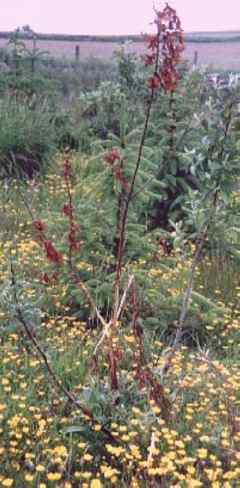|
Who Ate All the Trees? If only life were that simple. Who does the damage? Let us not forget sheep and goats, although good management will ensure that fences are well maintained and kept intact. But I have known those who thought letting the sheep in among the trees to keep the grass down would be a good idea. I have met no-one who thought the experiment worthy of repetition.
Apart from the risk of strangling the tree as it girths up, the main drawback with the vole guard is that is no deterrent to any other predator. And if you think voles will be your only problem, a penny to a pound you�ll be proved wrong at some stage. They may not be evident when the site is regularly worked, but once it�s quietly down to trees, all manner of creatures move in. However, vole guards are very effective against voles. By now, you�d be forgiven for thinking I have reservations about all these forms of tree protection. And you�d be right. But let me make this clear � if you have a serious predator problem, shelters or guards are essential. The flaw in the argument.. Believe it or not, tree shelters were originally developed and marketed, not as predator protection, but as growth accelerators. Indeed, they used to be commonly referred to as �growth tubes�. They would nurse the young tree in a protected environment, while the real world outside was cold, windy and generally hostile. The young tree would thrive in this environment, and shoot up rapidly. Spotted the flaw in the argument
yet? So pity the poor leading shoot which dares to pop its head out of the cosy shelter into a hostile north-easterly. Dieback in these circumstances is a regular occurrence. Leaders are lost, and trees eventually develop as shrubby bottle-brushes. In the real world, a young tree will develop at a pace in keeping with its environment. The more exposed the site, the more slowly the tree will grow. And the more sturdily. The wind whipping the stem will promote girth rather than height, and encourage the development of deep anchoring roots. The last thing we want to do is promote rapid, soft growth in an artificial environment. You can�t cheat Nature. How often have you seen substantial trees, still in their shelters, leaning at forty-five degrees, or even prostrate? So this is a strong argument for using mesh guards rather than solid shelters. But that still leaves the problem of branches growing through the mesh. And worse still. There is the problem of the tree girthing up and filling the guard, which then embeds itself in the tree, gradually strangling it. At least solid shelters are made to disintegrate after seven years or so, and in theory should split open under pressure. This doesn�t always work, of course, as different species grow at different rates. Rapidly-growing species, like wild cherry, can fill a shelter in three or four years, long before it has become brittle enough to give way under pressure. And of course, if shelters are left to deteriorate as they are designed to, the result is a plague of shredded plastic blowing across the countryside. Dispelling the myth.. My point is to dispel the myth that tree shelters are an unqualified �good thing�. They should be known, perhaps, as �tree protectors�. That, perhaps, would be more descriptive of their role. If predation in any of its forms is a threat, then some form of protection is essential. But shelters should always be recognised as a necessary evil, because the accelerated growth they promote is a distinct disadvantage, not an advantage. And shelters should never be used just for �shelter�. If at all possible, grow your trees unprotected, lean and mean, hard and tough, and let them acclimatise to their situation in their own way and in their own time. Cost Effective? Your trees will be hardier and sturdier, and you will have a mixed-age woodland as a bonus! Worth a thought, is it not? � Mike Clark 2003. |

